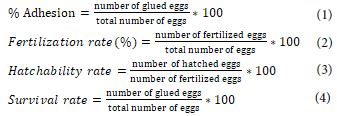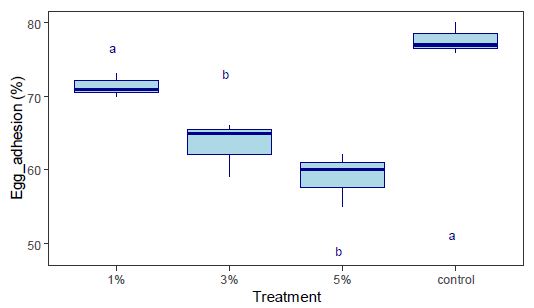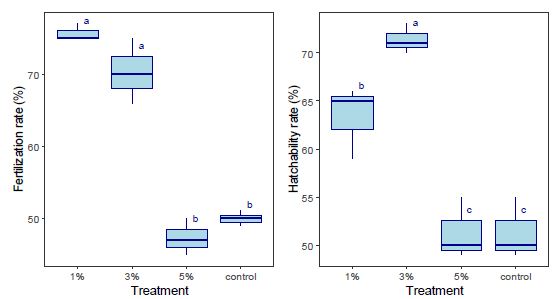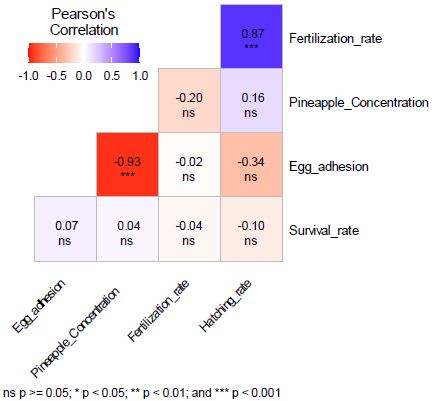DOI: 10.31038/CST.2021115
Abstract
This study was conducted from May to June 2018 at the National Fishery Hatchery in Ethiopia and aimed to assess the effectiveness of pineapple juice in the elimination of egg stickiness and improved hatchability rate in Clarias gariepinus. There were four different concentrations of pineapple juice tested: 0% (without juice), 1%, 3%, and 5%. The result revealed that egg stickiness was reduced dose-dependently (p < 0.05), with the 5% concentration showing the greatest reduction (59%) compared to the control group (77%). However, it was noted that higher concentrations of pineapple juice have adversely affected egg hatching and fertilization rates. The minimum observed fertilization rate (45%) was observed at the highest concentration tested (5%), while the maximum (77%) was observed at lower concentrations (1%). Similarly, the minimum hatching rate (51.5%) was observed at higher concentrations (5%), with the maximum (71.3%) at 3% pineapple concentrations. Despite these variations, no significant difference (p > 0.05) in the survival rate of juvenile catfish was observed across different concentrations of pineapple juice. This finding highlights the potential of pineapple juice as a practical and accessible approach for improving catfish hatching operations. This study helps to optimize catfish breeding procedures and demonstrates the efficacy of natural treatments in aquaculture practices.
Keyword
Clarias gariepinus, Pineapple juice, Egg stickiness, Hatchability, Fertilization
Introduction
Aquaculture is crucial for meeting the world’s expanding food demand. Sustainable aquaculture output is strongly dependent on good reproduction and efficient hatching methods. Fish seed mass propagation, whether artificial or semi-artificial, is essential to modern fish farming. Due to seasoned breeding habits in most culturable species and the fact that fish must be caught at a time that may not coincide with ideal production conditions, the natural supply of fingerlings is erratic, unstable, and insufficient. Of these species, the African catfish (C. gariepinus) reproduces according to its seasonal breeding behavior at particular periods of the year [1-3].
The African catfish is a valuable tropical aquaculture fish in Africa, Asia, and Europe. This is because the species is suitable for aquaculture due to its fast growth rate, tolerance of high stocking density and poor water quality, acceptance of both artificial and natural feeds, and high market demand, and high production in the pond, 2.5 times higher than tilapia. It is also the second most important commercial fish species in Ethiopia’s capture fishery next to the Nile tilapia. Despite this, the lack of good quality and quantity of seeds has been a major constraint in aquaculture development. Thus, at larvae and fry stages, low survival rates and poor growth performance are the major challenges in catfish production in Ethiopia. This is most probably related to egg stickiness, which needs to be reduced before eggs can be incubated successfully [3-7].
Chemical treatments like tannic acid, urea, and acylase enzyme are frequently used in traditional ways for reducing egg stickiness. However, the extensive use of such chemicals raises concerns about potential detrimental implications on water quality, fish health, and the general ecological balance of the aquaculture system. This procedure also takes a minimum of one hour and a great deal of labor and experience. As a result, this circumstance forces people to look for more eco-friendly alternatives, like pineapple juice [8-12].
In catfish hatcheries, recent studies on the use of pineapple juice as an alternate egg-sticking reduction agent have produced encouraging results. According to preliminary research, bromelain in pineapple juice significantly decreased the stickiness of catfish eggs, offering a healthy and natural alternative. Pineapple is widely available in many tropical nations, including Ethiopia. It includes several proteolytic enzymes, primarily bromalinases, which can breakdown proteins. The skin and hump of pineapple contain tannin chemicals, which belong to the phenol group. Tannins can eliminate egg adhesion because they can bind and precipitate protein compounds due to the presence of functional bond groups that interact strongly with protein molecules, resulting in large and complex cross-links, known as tannin-protein [13-17].
With sustainability becoming a top priority in the aquaculture sector, this study attempts to thoroughly explore green ways to enhance the hatchability of catfish eggs. Therefore, in order to overcome the drawbacks of chemical agents, this study aimed to evaluate pineapple juice’s potential as a natural substance to remove egg stickiness and increase the hatchability rate in catfish. This is in line with the necessity of ethical and ecologically friendly aquaculture methods, guaranteeing the sustainability of Ethiopia’s catfish aquaculture sector.
Materials and Methods
Broodstock Selection and Hormone Administration
The experiment was conducted from May to June 2018 at the National Fisheries and Aquatic Life Research Center, NFALRC, hatchery. Three males and three females of C. gariepinus broodstock, weighing between 958 and 1000 grams, were taken from the NFALRC ponds. Priority was given to individuals presenting an elongated papilla and a slightly swollen reddish urogenital organ for male brooder selection. While, criteria including a well-rounded and soft abdomen, extending anteriorly beyond the pectoral fins to the genital opening were used for female brood stock selection. The broodstocks were acclimatized in separated tanks in hatchery for 24 hours.
The female brooders were artificially stimulated using 0.3 ml of common carp pituitary gland per kilogram of body weight, as described by Olanrewaju et al. The injection was done intramuscularly above the lateral line just below the dorsal fin. The female brooder was given light abdominal pressure twelve hours following the injection, at which point the ovulated eggs were gathered and weighed to the closest 0.01 g in a dry, clean plastic dish. The milt was collected by sacrificing the male broodstock. The milt and eggs were mixed and two drops of saline water were added to activate the milt and stirred gently with a feather to fertilize the eggs. The eggs were left for one minute to provide sufficient contact with the milt [18,19].
Pineapple Juice Preparation and Application
Pineapple juice was prepared by squeezing freshly peeled fruit from a local market in Sebeta, Ethiopia. Three pineapple juice concentrations, including 1% (1 ml of juice to 99 ml of clean water), 3% (3 ml of juice to 97 ml of clean water), and 5% (5 ml of juice to 95 ml of clean water), as well as a control group without pineapple juice, were prepared to investigate dose-dependent effects. In order to represent each concentration of pineapple juice, the fertilized eggs were divided into four equal parts weighing 800 g each. These portions were then divided in triplicate. After pouring the juice solution over the eggs, the mixture was constantly swirled for approximately three minutes using a feather.
Experimental Design and Water Management
For egg hatching, a total of twelve 200-liter plastic bowls were utilized, one for each of the four treatments in triplicate. A mesh was placed above the water surface within the bowl to provide a platform for placing fertilized catfish eggs treated with pineapple juice. The eggs were gently poured over the mesh, ensuring uniform distribution above the water surface. In order to guarantee sufficient oxygenation, a constant water flow was maintained during the trial. The ideal conditions for embryonic development were preserved by controlling the flow rate. In order to facilitate the incubation of catfish eggs, the water temperature was carefully monitored and changed to 24 to 27°C. Water quality indicators such as temperature, pH, and dissolved oxygen levels were carefully monitored at regular intervals throughout the 36-hour experiment. The hatching success criterion was defined as the emergence of larvae from egg capsules. Dead eggs, which are white and transparent, are removed immediately.
Data Collection
Egg adhesiveness was assessed by determining the percentage of eggs that formed clumps. After 15 minutes of incubation, the eggs that had formed clumps within each container were counted. The percentage of adhesion, fertilization, hatching, and survival rate were determined using the standard formula (Eq1 to Eq4) [20,21].

Statistical Analysis
The collected data on egg stickiness and hatchability rates for each concentration was statistically analyzed using R statistical software, with a one-way ANOVA used determine the significant differences between the treatment and different variables. Pearson’s correlation was used to assess the relationship between pineapple juice concentrations and fertilization and hatchability parameters [22].
Results and Discussion
Physicochemical Parameters
The result of major physicochemical parameters is presented in Table 1. Our study indicated that water temperature (24-27°C), dissolved oxygen (>5 mgL-1), pH (7.12-7.16), and ammonia levels (< 0.1 mgL-1) remained within optimal ranges for effective hatching in catfis. Effective water quality management strategies are critical for providing an optimal environment for catfish embryogenesis [23,24].
Table 1: Physicochemical water quality parameters with mean ± SD
|
Parameters |
Range |
Mean ± SD |
| DO (mgL-1) |
5.8 – 6.6 |
6.2 ± 0.4 |
| pH |
7.12 – 7.16 |
7.1 ± 0.2 |
| Temperature (°C) |
24 – 27.5 |
25 ± 0.3 |
| Ammonia (mgL-1) |
0.1 – 0.15 |
0.1 ± 0.05 |
Effect of Pineapple Juice Concentrations on Cat Fish Egg Stickiness
Supplementing catfish eggs with pineapple juice resulted in a significant reduction in stickiness (ANOVA, p < 0.05) at varied doses (Figure 1). It was found that all of the treatments reduced the adhesiveness of C. gariepinus eggs to varying degrees. The control group, without pineapple juice, had the highest adhesion value (78.6%) showing the least reduction in egg stickiness. Interestingly, the greatest concentration, 5%, showed the highest reduction in egg adhesion (61%). The 3% pineapple juice concentration resulted in a medium reduction (67.3%). Subsequent post-hoc Tukey’s tests indicated a significant decrease in egg stickiness for the 3% and 5% concentrations compared to the control. This could be explained by the different concentrations of the enzyme bromelain in pineapple juice, which breaks down protein in a sticky fish egg layer. Fish eggs are sticky when they come into touch with water because of their high protein cortical envelope. The more easily the bromelain enzyme can break protein molecules into smaller forms, the more effective it is at eroding the protein layer found in catfish eggs. Our findings corroborate this theory because we found that the amount of egg stickiness decreased more noticeably at greater pineapple juice concentrations [25-28].

Figure 1: Egg adhesion across different pineapple juice concentrations. Letters a and b indicate significant differences between treatments (P < 0.05).
Our result aligns with previous studies indicating the potential of pineapple juice to affect adhesive properties with dose-dependent stickiness reduction in catfish eggs. The egg of C. gariepinus has a sticky layer, which is composed of glycoprotein. Because of its proteolytic action, bromelain may interact with the glycoproteins on the egg surface, changing their sticky characteristics and changing the way the egg clumps.
Furthermore, the slight decrease in stickiness that was seen at lower pineapple juice concentrations (1%), which points to a possible threshold effect wherein enzyme activity might not be enough to cause appreciable changes in sticky characteristics. This suggests a dose-dependent effect of pineapple juice on egg adhesiveness, with lower concentrations potentially leading to greater egg aggregation. Excessive egg clumping may result in restricted water flow around individual eggs and poor oxygenation. Furthermore, it reduces oxygen levels and increases fungal infection, leading to higher mortality rates.
Fertilization and Hatchability Rate
The result of fertilization and hatching rates are presented in Figure 2 with significant variation among treatments (ANOVA, p < 0.05). In comparison to the control group, treatment with 1% concentration resulted in a higher improvement in fertilization rates (77%), which was less than the values reported by Nwerich and Igill-Iboi (88%), Sukendi et al. (89.5%), Egwenomhe et al. (98.6%) in C. gariepinus, and Thal and Ngo (89.5%) in C. carpio. Surprisingly, the 5% concentration, despite reducing egg stickiness significantly, showed a decline in fertilization rates (45%). The highest fertilization value obtained in this study was not related to the smallest adhesion value obtained, which suggests that additional influencing elements as well as the egg adhesion value affect the fertilization value. This is in agreement with the previous studies which reported the highest fertilization rate in the lowest concentrations of pineapple juice solution. This research implies that pineapple juice improves fertilization rates at specific concentrations, while greater concentrations may have a negative impact on sperm-egg interactions [13-16].

Figure 2: The fertilization and hatching rate across treatments. Letters indicate a significant difference between treatments (p < 0.05).
The egg’s adhesiveness makes it more difficult for the embryo to hatch successfully in artificial breeding. This is because the eggs have become agglutinated, covering the micropyles and making it more difficult for sperm to fertilize them. As a result, there are less opportunities for sperm to come into touch with the eggs, which lowers the likelihood that the eggs will be fertilized. Other substances, such as pineapple juice, are used to crack the egg layer, which accelerates fertilization by allowing sperm to make direct contact with the eggs without being impeded by the mucus coating on the egg surface [14-16].
There was significant variation in hatching rate among treatments (p < 0.05). The highest hatching rate was obtained in the 3% pineapple juice concentrations (71.3) and showed a decrease (51.5%) in the 5% concentrations. Similar results were found in the previous studies confirming the dose-dependent trend in egg hatchability of 86.6 % at 1% concentration and decreasing to 25.3 % at 5% concentration. Similarly reported 78.1 % hatching rate at 0.75% pineapple juice concentration and decreased to 75.6% at 1% concentration [18].
This emphasizes the critical role of optimal pineapple juice concentration in influencing not only fertilization but also hatchability in catfish. This shows the effect of pineapple juice in reducing the adhesive layer of catfish eggs. In normal cases, when the eggs come in contact with water for a while, and clump reducing the prospect of the eggs hatching. In general, destocking of eggs using pineapple is quick and simple and requires three minutes only instead of the one hour for conventional desticking techniques. This technique is easy to adopt and advantageous by dramatically reducing the egg handling period.
Survival Rates of Hatched Fish
The survival rates of fish in treatment groups were extensively observed after hatching (Table 2). The larvae survival rate varied from 84% in 1% pineapple concentration to 90% in 3% pineapple concentration, with no significant difference across treatments (p > 0.05). The general survivability of the growing larvae may not be directly impacted by the enzymatic activity of bromelain, which mainly modifies protein structures and sticky characteristics. Similar results were observed in the previous studies [16,17].
Table 2: Survival rate of catfish fries at different pineapple juice concentrations
|
Concentrations |
Number of hatchlings |
Survival rate (%) |
|
0% (control) |
261 |
87 |
|
1% |
259 |
84 |
|
3% |
315 |
90 |
|
5% |
291 |
89 |
The Response of Different Variables to Pineapple Concentrations
The relationship between different parameters and pineapple juice concentrations is indicated using Pearson’s correlation (Figure 3). The pineapple juice concentrations exhibited a strong negative correlation with egg adhesion (ANOVA, p < 0.001, r2=-0.93), indicating that higher concentrations of pineapple juice led to reduced egg adhesiveness. This is associated with the presence of proteolytic enzymes in the pineapple juice that can inhibit the activities of glycoprotein which could have the potential of increasing the sticky layer of fish eggs. Similar reports were found on the negative correlation between pineapple concentrations and fish egg adhesiveness. Although not statistically significant, there was a negative correlation found between the concentrations of pineapple juice and the rates of fertilization and hatching. Similarly, report state a decrease in fertilization and hatching rate with a corresponding increase in the concentration of the pineapple juice. On the other hand, hatching rates and fertilization rates exhibited a positive correlation (ANOVA, p < 0.001, r2=0.87), indicating a comparable response to the concentrations of pineapple [16,17].

Figure 3: Person’s correlation showed the relationship between pineapple juice concentrations and different parameters.
The findings underscore the potential of pineapple juice as a natural agent for manipulating reproductive parameters in aquatic organisms, offering insights into its application in aquaculture practices for improving breeding success and egg quality. However, pineapple juice concentration matters at a certain concentration and might be detrimental over the optimal dosage.
Conclusion and Recommendation
In conclusion, the application of pineapple juice solution has demonstrated efficacy in reducing the stickiness of Clarias gariepinus eggs, offering a practical solution for hatcheries in Ethiopia. Our findings suggest that this method not only effectively mitigates the adhesive properties of the eggs but also presents a user-friendly approach that does not necessitate specialized expertise for implementation. Moreover, while higher concentrations of pineapple juice may have adversely affected egg hatching and fertilization rates, it’s noteworthy that the positive impact on egg-destocking adhesiveness was observed. Therefore, this approach holds promise as a simple and accessible solution for hatchery operations, allowing for improved handling and management of catfish eggs without requiring extensive training or technical skills. To optimize hatchery operations and improve the management of Clarias gariepinus eggs in Ethiopia, the following recommendations are proposed:
- Incorporate pineapple juice solution application to reduce egg stickiness effectively.
- Utilize lower concentrations of pineapple juice to maintain optimal hatching and fertilization rates while mitigating egg adhesiveness.
Acknowledgements
We would like to acknowledge the National Fisheries and Aquatic Life Research Center (NFALRC) for financing the research work.
References
- Ojutiku RO (2008) Comparative Survival and Growth Rate of Clarias gariepinus and Heteroclarias Hathclings Fed Live and Frozen Daphnia. Pakistan Journal of Nutrition 7(4).
- Adebayo OT (2006) Reproduction performance of African catfish Clarias gariepinus broodstocks on varying maternal stress. Journal of Fish Biology 1(2).
- Dadebo D, Gebre-Mariam Z, Mengistou S (2011) Breeding season, maturation, Fecundity and condition factor of the African catfish Clarias gariepinus Burchell 1822 (Pisces: Clariidae) in Lake Chamo, Ethiopia. Ethiopian Journal of Biological Science 10(1).
- FAO (2020) The State of World Fisheries and Aquaculture. Sustainability in action. Rome.
- Amachree D, Akinrotimi OA, Dabor PO (2018) Effects of Different Physiological Saline Concentrations on the Reproductive Performance of Clarias gariepinus (Burchell, 1822). Journal of FisheriesSciences 12(4).
- Ponzoni RW, Nguyen NH (2008) Proceedings of a Workshop on the Development of a Genetic Improvement Program for African Catfish, Clarias gariepinus. Accra, Ghana, pp 131.
- Abdelhamid AM, Radwan IA Mehrim A, Abdelhamid AF (2010) Improving the survival rate of the African catfish, Clarias gariepinus. Journal of Animal and Poultry Production, Mansoura University 1: 409-414.
- Zarski D, Krejszeff S, Kucharczyk D, Palinska-Zarska K, Targonska K (2015) The application of tannic acid to the elimination of egg stickiness at varied moments of the egg swelling process in pikeperch, Sander lucioperca (L.). Aquaculture Research 46 (2).
- Asraf A, Muchlisin ZA, Siti-Azizah MN (2013) Removal of eggs adhesiveness of African catfish (Clarias gariepinus) at different concentrations of urea solution. Aceh International Journal of Science and Technology 2(3): 94-97.
- Linhart O, Rodina M, Gela D, Kocour M, Rodriguez M (2003) Improvement of common carp artificial reproduction using enzyme for elimination of egg stickiness. Aquatic Living Resources 16: 450-456.
- Linhart O, Rodina M, Gela D, Flajšhans M, Kocour M (2004) Enzyme treatment for elimination of egg stickiness in tench (Tinca tinca), European catfish (Silurus glanis L.) and common carp (Cyprinus carpio L.). Fish Physiology and Biochemistry 28: 507-508.
- Horvath L, Tamas G, Seagrave C (2002) Carp and Pond Fish Culture. Blackwell Science, pp. 23-56.
- Nwachi OF, Igill-Iboi M (2014) Experimental Trials of the use of Pineapple juice in disticking Clarias gariepinus egg in indoor hatchery at Niger Delta Area. Nigeria. Journal of Natural Sciences Research 4(18).
- Sule OD, Adikwu I (2004) Embryonic development in clarias gariepinus (buchell, 1822) under laboratory conditions. Animal Research International 1(2).
- Egwenomhe M, Yusuf A, Ihenyen E, Sadiq HO, Nwabuma EI (2022) The Effects of Pineapple and Orange Juice as De-Adhesion Agents on Clarias gariepinus (African catfish) Eggs. Dutse Journal of Pure and Applied Sciences 8: 70-76.
- Sukendi T, Putra RM Nuraini AD (2022) The use of pineapple extract to remove egg adhesiveness in the production of Asian redtail catfish fry (hemibagrus nemurus cv). OP Conf. Ser: Earth Environ.
- Payne DE, Martin NR, Parzych KR, Rickard AH, Underwood A, Boles BR (2013) Tannic acid inhibits Staphylococcus aureus surface colonization in an IsaA-Dependent Manner. Infection and Immunity, American Societr for Microbiology 81: 2-13.
- Zakes KD, Zdzisław Z, Jakub R (2005) The use of tannic acid to remove adhesiveness from pikeperch, Sander lucioperca, and eggs. Aquaculture Research 36: 1458-1464.
- Olanrewaju AN, Agbelege OO, Saidu AK (2009) Growth and production of fingerlings of Dutch Clarias gariepinus in indoor tanks in arid zone, (FISON) 25-28. pp. 8-10.
- Legendre M, Linhart O, Billard R (1996) Spawning and management of gametes, fertilized eggs and embryos in Siluroidei. Aquat Living Resour 9: 59-80.
- R Core Team (2018) R: A Language and Environment for Statistical Computing; R Foundation for Statistical Computing, Vienna, Austria.
- Islam MM, Amin AA, (2016) The induced breeding of common carps (Cyprinus carpio) in Bangladesh. Indian journal of science and technology 23(84).
- Liu Y, Hu J, Zhou S, Yang R, Qin J, Ma Z, Yang Q (2018) Effect of Acute Ammonia Stress on Antioxidant Enzymes and Digestive Enzymes in Barramundi Lates calcarifer Larvae. Indian Journal of Anaesthesia.
- Ataguba GA, Okomoda VT, Ukpong P (2022) Optimization of induced breeding of Clarias gariepinus using different sources of water. Livestock Research for Rural Development 34: 80-88.
- Kudo S (1982) Ultra Structural Modifications of fertilization Envelope in the Carp Egg. Growth and Differ 24 (4).
- Utami DP (2010) The Effect of Addition of Pineapple Extract and Different Cooking Times on the Quality of Duck Flesh [Thesis]. Surakarta: Eleven March University.
- Ljubobratović U, Csengeri I, Kucska B, Balogh E Lengyel S (2017) Comparison of the Procedures for Adhesiveness Removal in Pikeperch Eggs with Special Emphasis on the Effect of Tannic Acid. Turkish Journal of Fisheries and Aquatic Sciences 469: 461-469.
- Thai BT, Ngo TG (2004) Use of Pineapple Juice for Elimination of Egg Stickiness of Common Carp (Cyprinus carpio L.). Asian Fisheries Science 17: 159-162.